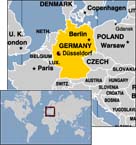Once roughly hewn, eco-furniture now a cut above
 Wiesbaden, Germany - Until fairly recently, only eco-freaks were seriously interested in environmental protection. Then global warming became a hot topic, and suddenly environmental protection is everybody's business.
Wiesbaden, Germany - Until fairly recently, only eco-freaks were seriously interested in environmental protection. Then global warming became a hot topic, and suddenly environmental protection is everybody's business.
Natural materials and all things "bio" and "eco" are much in demand. The home furnishings industry does not want to be left out, so manufacturers now tout sofas, shelves and sets of dishes as being "ecological." They want nothing to do with a "granola" image, however.
Indeed, the image conjured up by "ecological" or "environmentally friendly" has undergone a transformation. As applied to home furnishings, the terms are no longer synonymous with roughly hewn, natural wood furniture and cotton carpets. These days they are compatible with contemporary and avant-garde design.
"For a long time, the term "eco" had a negative connotation - you always associated it somehow with hand knitting," remarked Irene Fromberger of the Wiesbaden-based design consultancy Form und Folgen (Form and Consequences). That was beginning to change, she added.
"It's becoming fashionable to be "eco" nowadays," according to a study by Hamburg-based Trendbuero, which calls itself a "consultancy for social change." The firm noted that "with pop stars as role models, 'green' thinking and environmental consciousness are becoming a cool lifestyle."
To earn the label "ecologically correct," a piece of furniture should be environmentally friendly in terms of production, service life, and recyclability, said Ursula Geismann of the Bad Honnef-based German Furniture Industry Association (VDM). It should be made mainly of natural materials, and when it is thrown away, all of the materials must be separable.
Though that sounds self-evident, it is still the exception. "There is definitely furniture that has to be disposed of as hazardous waste," Geismann said. But she has noticed a change. "People are becoming more aware of environmental and health issues. Their sensitivity is rising, in the area of high-quality consumer goods too," she said.
One reason eco-furniture and home accessories are attracting an increasing number of consumers is that new design eoncepts are bringing ecology together with contemporary forms and colours.
The company Bruehl, in the Bavarian town of Bad Steben, shows how that can be done with upholstered furniture. Outwardly, its soft, organically formed Mosspink sofa is indistinguishable from conventionally produced sofas.
Inside, however, Mosspink is entirely different. It has a solid wooden frame, a high-quality upholstered base, and cushions with covers - either leather or fabric - that carry the European Union's eco label, said managing director Roland Meyer-Bruehl.
One material in particular is riding the green wave: bamboo, which is extremely popular this year. Quickly renewable and very durable, it is used for things including parquet floors and chests of drawers, but mostly for accessories.
In the view of Trendbuero's lifestyle researchers, the notion of luxury with be replaced in future by humaneness, environmental consciousness, and sustainability. "No longer is it merely the purchased item that receives the buyer's personal appreciation, but the whole production process," the company said. (dpa)